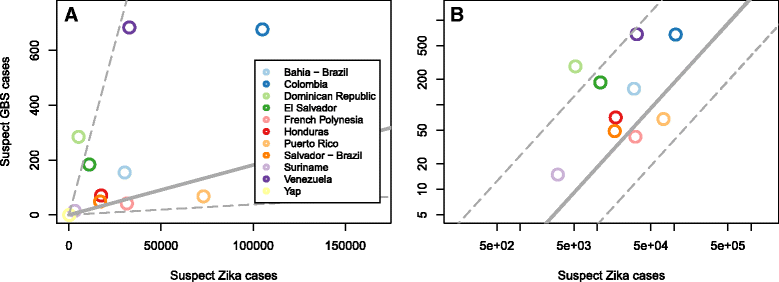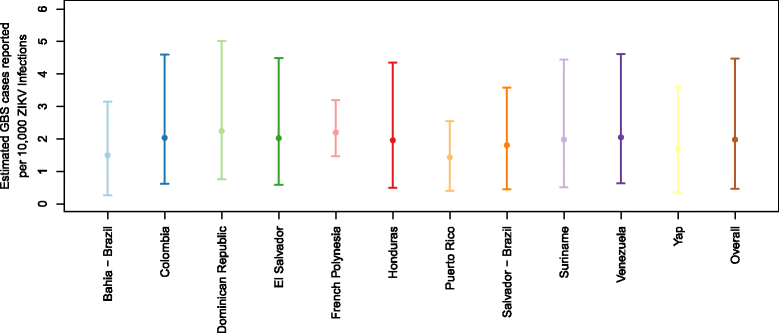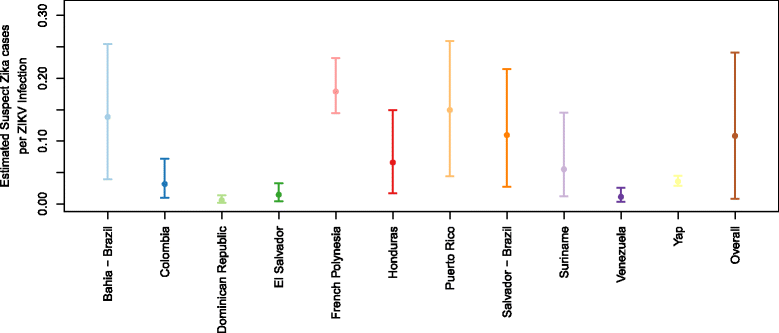Guillain-Barré syndrome risk among individuals infected with Zika virus: a multi-country assessment
- PMID: 29759069
- PMCID: PMC5952697
- DOI: 10.1186/s12916-018-1052-4
Guillain-Barré syndrome risk among individuals infected with Zika virus: a multi-country assessment
Abstract
Background: Countries with ongoing outbreaks of Zika virus have observed a notable rise in reported cases of Guillain-Barré syndrome (GBS), with mounting evidence of a causal link between Zika virus infection and the neurological syndrome. However, the risk of GBS following a Zika virus infection is not well characterized. In this work, we used data from 11 locations with publicly available data to estimate the risk of GBS following an infection with Zika virus, as well as the location-specific incidence of infection and the number of suspect GBS cases reported per infection.
Methods: We built a mathematical inference framework utilizing data from 11 locations that had reported suspect Zika and GBS cases, two with completed outbreaks prior to 2015 (French Polynesia and Yap) and nine others in the Americas covering partial outbreaks and where transmission was ongoing as of early 2017.
Results: We estimated that 2.0 (95% credible interval 0.5-4.5) reported GBS cases may occur per 10,000 Zika virus infections. The frequency of reported suspect Zika cases varied substantially and was highly uncertain, with a mean of 0.11 (95% credible interval 0.01-0.24) suspect cases reported per infection.
Conclusions: These estimates can help efforts to prepare for the GBS cases that may occur during Zika epidemics and highlight the need to better understand the relationship between infection and the reported incidence of clinical disease.
Keywords: Guillain–Barré syndrome; Zika virus; neurological disorder; vector-borne diseases.
Conflict of interest statement
Competing interests
The authors declare that they have no competing interests.
Publisher’s Note
Springer Nature remains neutral with regard to jurisdictional claims in published maps and institutional affiliations.
Figures



Similar articles
-
Real-Time Assessment of Health-Care Requirements During the Zika Virus Epidemic in Martinique.Am J Epidemiol. 2017 Nov 15;186(10):1194-1203. doi: 10.1093/aje/kwx008. Am J Epidemiol. 2017. PMID: 28200111 Free PMC article.
-
Guillain-Barré Syndrome and Zika Virus: Estimating Attributable Risk to Inform Intensive Care Capacity Preparedness.Clin Infect Dis. 2016 Sep 1;63(5):708-9. doi: 10.1093/cid/ciw355. Epub 2016 May 25. Clin Infect Dis. 2016. PMID: 27225243 No abstract available.
-
Zika virus infection and Guillain-Barré syndrome: a review focused on clinical and electrophysiological subtypes.J Neurol Neurosurg Psychiatry. 2017 Mar;88(3):266-271. doi: 10.1136/jnnp-2016-314310. Epub 2016 Oct 31. J Neurol Neurosurg Psychiatry. 2017. PMID: 27799296 Review.
-
Zika Virus Infection in the Elderly: Possible Relationship with Guillain-Barré Syndrome.Gerontology. 2017;63(3):210-215. doi: 10.1159/000453579. Epub 2016 Dec 22. Gerontology. 2017. PMID: 28002820 Review.
-
Zika virus disease-associated Guillain-Barré syndrome-Barranquilla, Colombia 2015-2016.J Neurol Sci. 2017 Oct 15;381:272-277. doi: 10.1016/j.jns.2017.09.001. Epub 2017 Sep 4. J Neurol Sci. 2017. PMID: 28991697
Cited by
-
Distinct Replication Kinetics, Cytopathogenicity, and Immune Gene Regulation in Human Microglia Cells Infected with Asian and African Lineages of Zika Virus.Microorganisms. 2024 Sep 5;12(9):1840. doi: 10.3390/microorganisms12091840. Microorganisms. 2024. PMID: 39338514 Free PMC article.
-
Zika virus infection causes temporary paralysis in adult mice with motor neuron synaptic retraction and evidence for proximal peripheral neuropathy.Sci Rep. 2019 Dec 20;9(1):19531. doi: 10.1038/s41598-019-55717-3. Sci Rep. 2019. PMID: 31862897 Free PMC article.
-
Antecedent infections in Guillain-Barré syndrome in endemic areas of arbovirus transmission: A multinational case-control study.J Peripher Nerv Syst. 2021 Dec;26(4):449-460. doi: 10.1111/jns.12469. Epub 2021 Sep 30. J Peripher Nerv Syst. 2021. PMID: 34549484 Free PMC article.
-
Effects of Statin Combinations on Zika Virus Infection in Vero Cells.Pharmaceutics. 2022 Dec 23;15(1):50. doi: 10.3390/pharmaceutics15010050. Pharmaceutics. 2022. PMID: 36678679 Free PMC article.
-
Postnatal symptomatic Zika virus infections in children and adolescents: A systematic review.PLoS Negl Trop Dis. 2020 Oct 2;14(10):e0008612. doi: 10.1371/journal.pntd.0008612. eCollection 2020 Oct. PLoS Negl Trop Dis. 2020. PMID: 33006989 Free PMC article.
References
-
- World Health Organization . Zika Situation Report, March 10. Geneva: WHO; 2016.
-
- CDC . CDC Concludes Zika Causes Microcephaly and Other Birth Defects. 2016.
Publication types
MeSH terms
Grants and funding
LinkOut - more resources
Full Text Sources
Other Literature Sources
Medical

